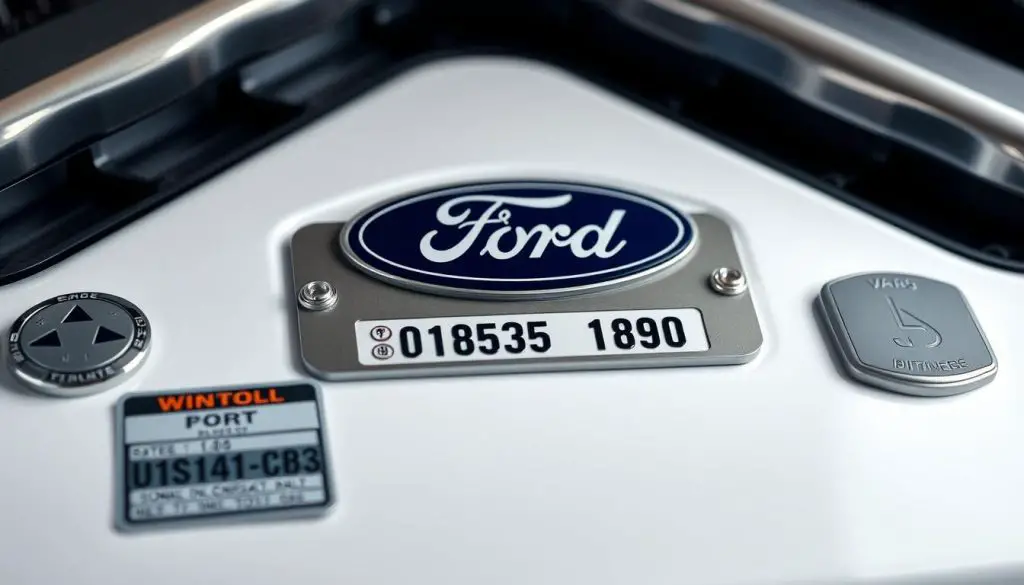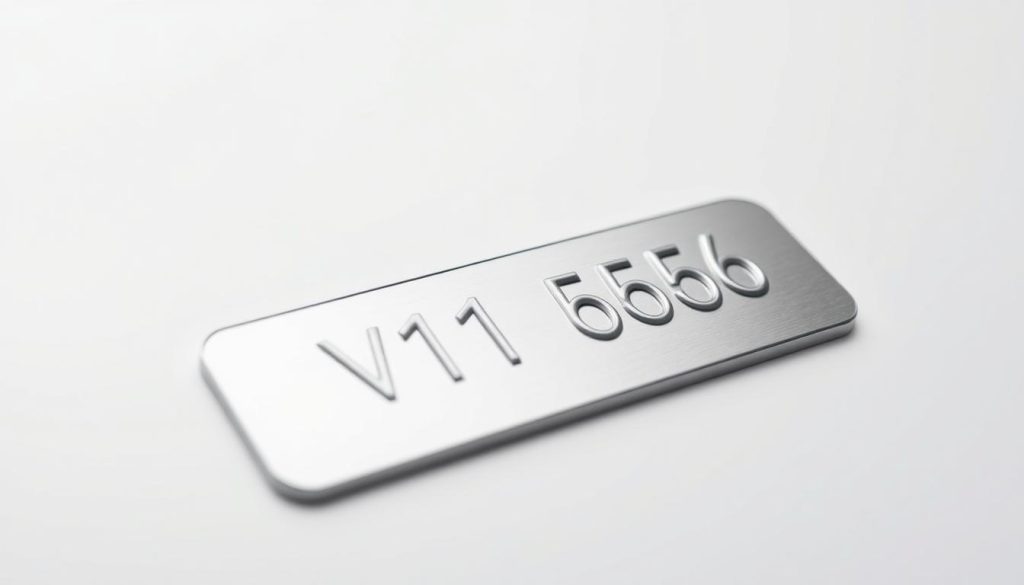For Ford owners, grasping the complexities of their vehicle is paramount for ensuring its optimal maintenance and appreciating its historical and technical nuances.
The Vehicle Identification Number (VIN) and badges on Ford vehicles encapsulate vital information, significantly enriching the ownership experience.
Acquaintance with the details encoded in the VIN and the importance of various badges empowers owners to authenticate their vehicle’s legitimacy, comprehend its production specifics, and uphold it in accordance with its technical specifications.
Key Takeaways
- Understanding the VIN aids in verifying the vehicle’s history and specifications.
- Badges on Ford vehicles provide additional information about the vehicle’s features and capabilities.
- Knowledge of VIN and badges enhances the overall ownership experience.
- It aids in maintaining the vehicle according to its specific requirements.
- Verifying the VIN and badges can help in authenticating the vehicle.
The Importance of Ford Vehicle Identification
Understanding the identification specifics of your Ford vehicle is paramount for unlocking its full potential and preserving its value. Vehicle identification transcends mere knowledge of make and model; it delves into the unique characteristics that distinguish your vehicle from others.
Why Vehicle Identification Matters for Ford Owners
For Ford owners, the significance of vehicle identification cannot be overstated. It guarantees that any maintenance or repairs are executed with precision. Adherence to the manufacturer’s guidelines and the use of correct parts are indispensable for sustaining your vehicle’s performance and longevity. Accurate vehicle identification is instrumental in averting misdiagnosis and ensuring your vehicle receives appropriate care.
Accurate identification is also critical when procuring parts or seeking warranty claims. It enables Ford dealerships and mechanics to provide the correct service, minimizing the likelihood of incorrect parts being installed.
How Proper Identification Affects Maintenance and Resale Value
Proper identification of your Ford vehicle has a profound impact on its maintenance and resale value. By possessing knowledge of your vehicle’s specific identification details, you can ensure that maintenance is conducted in accordance with Ford’s specifications. This approach preserves your vehicle’s performance and extends its lifespan.
| Identification Aspect | Impact on Maintenance | Impact on Resale Value |
|---|---|---|
| VIN Accuracy | Ensures correct parts ordering | Provides clear vehicle history |
| Badge Identification | Helps in understanding vehicle specifications | Indicates trim level and features |
| Model Year Verification | Aids in following the correct maintenance schedule | Affects vehicle depreciation and value |

Decoding Your Ford’s VIN Number
The VIN, or Vehicle Identification Number, is a unique code assigned to every Ford vehicle, encapsulating vital information about its identity. This 17-digit number transcends mere characters; it serves as a gateway to understanding the vehicle’s history, specifications, and authenticity.
What Is a VIN and Why It Matters
A Vehicle Identification Number (VIN) is a 17-digit code assigned to every vehicle manufactured globally. For Ford owners, grasping the VIN’s significance is paramount, as it harbors critical details about the vehicle’s make, model, year of production, engine type, and more. This information is indispensable for maintenance, repairs, and verifying the vehicle’s authenticity.
The 17-Digit Structure Explained
The 17-digit VIN is meticulously structured to convey specific details about the vehicle. The initial three digits signify the country of origin, manufacturer, and vehicle type. The subsequent six digits comprise the Vehicle Descriptor Section (VDS), detailing the vehicle’s model, engine type, and other attributes. The final eight digits are the Vehicle Identification Section (VIS), with the last four digits denoting the vehicle’s production sequence number.

Ford-Specific VIN Characteristics
Ford vehicles exhibit specific characteristics encoded in their VINs. For instance, the eleventh digit indicates the assembly plant where the vehicle was manufactured. This knowledge empowers Ford owners to decode their vehicle’s VIN more effectively, unveiling insights into its production details.
| VIN Position | Information | Example |
|---|---|---|
| 1-3 | Country, Manufacturer, Vehicle Type | 1FA |
| 4-8 | Vehicle Descriptor Section (VDS) | FP785 |
| 9 | Check Digit | 4 |
| 10 | Model Year | K |
| 11 | Assembly Plant | F |
| 12-17 | Production Sequence Number | 123456 |
Where to Find Your Ford’s VIN
The VIN of your Ford vehicle, a 17-digit code, is situated in multiple locations across your vehicle and within associated documentation. Identifying these locations is imperative for upkeep, registration, and other essential tasks.
Primary VIN Locations on Ford Vehicles
The primary site for the VIN on most Ford vehicles is the driver’s side dashboard, proximal to the windshield. This location is accessible from the exterior. The VIN can also be discovered on the driver’s side doorjamb or within the engine compartment. Certain models may exhibit the VIN on the trunk or rear doorjamb.
- Driver’s side dashboard near the windshield
- Driver’s side doorjamb
- Engine compartment
Secondary VIN Locations and Documentation
Beyond the primary locations, your Ford’s VIN is also present in various documents and secondary locations. It can be found in your vehicle’s registration, insurance documents, and the owner’s manual. Some Ford vehicles may feature a VIN label on the spare tire or beneath the floor covering in the trunk.
Key documents to check:
- Vehicle registration
- Insurance documents
- Owner’s manual
Having access to your VIN is crucial for confirming your vehicle’s identity and historical background.
Understanding Ford VIN Position Meanings
The VIN transcends its role as a mere identifier, serving as a portal to the vehicle’s lineage and technical details. Comprising 17 digits, it is segmented into various components, each conveying distinct information about the automobile.
Manufacturer and Country Codes (Position 1-3)
The initial three digits signify the World Manufacturer Identifier (WMI). This identifier is paramount, as it discloses the country of origin and the manufacturer. For Ford vehicles produced in the United States, the WMI typically commences with “1FA” or “1FM.” Grasping the WMI is fundamental for affirming the authenticity and provenance of your Ford vehicle.
Vehicle Attributes (Position 4-8)
The VIN’s segments 4 through 8 elucidate the vehicle’s attributes, encompassing model, engine type, and restraint system. For instance, the fourth digit might signify the model line, whereas the fifth digit could denote the engine type. These attributes are indispensable for ascertaining the appropriate parts and accessories for your vehicle, as well as comprehending its performance capabilities.
Security Check Digit and Model Year (Position 9-10)
The ninth digit is a security check digit designed to validate the VIN’s integrity. The tenth digit encodes the model year of the vehicle, adhering to a specific standard. For example, the letter “H” signifies the year 2017, while “J” denotes 2018. Acquaintance with the model year is imperative for maintenance, registration, and insurance purposes.
Plant Code and Production Sequence (Position 11-17)
The VIN’s final seven digits comprise the plant code and the production sequence number. The eleventh digit indicates the assembly plant of origin, while the subsequent digits represent the unique production sequence number assigned to the vehicle. This information is invaluable for tracing the vehicle’s history and verifying its authenticity.
Deciphering the meanings behind each position in your Ford’s VIN offers profound insights into its specifications, history, and authenticity. This comprehension is not merely beneficial for maintenance and repairs but also crucial for verifying the vehicle’s history during transactions.
Understand Your Ford: Badge and Emblem History
The narrative of Ford’s badge and emblem evolution is a captivating reflection of the automotive sector’s progression and shifting consumer tastes. The visual representation of Ford vehicles has been meticulously crafted through a blend of innovation, design refinement, and strategic branding choices over the decades.
Evolution of the Ford Logo
Since its establishment in 1903, the Ford logo has undergone profound transformations. Initially, it showcased a complex design, incorporating the company’s name and founding year. This design has gradually evolved into a more streamlined and universally recognized emblem.
Notable milestones in this evolution include:
- The introduction of the iconic blue oval logo in 1927, which has remained a core element of Ford’s branding.
- Simplification of the logo in the 1970s, focusing on the blue oval without additional text.
- Modern digital enhancements and variations for different applications.
The blue oval has become an emblematic representation of Ford’s heritage and quality.
Special Edition and Limited Release Badges
Ford has employed special badges to signify limited edition models, performance variants, and commemorative versions. These badges often highlight unique features or enhancements.
Examples include:
- The Ford Mustang Shelby GT500 badge, indicating a high-performance variant.
- Limited edition badges for anniversary models or special production runs.
Trim Level Identifiers
Trim level identifiers are essential for grasping the specifications and features of a Ford vehicle. Badges such as XL, XLT, Lariat, and others denote different trim levels, each with its own set of standard features and options.
These identifiers facilitate consumers and enthusiasts in swiftly identifying the vehicle’s configuration and capabilities.
Deciphering Ford Model Badges
The badges adorning your Ford vehicle transcend mere ornamentation; they unveil pivotal information regarding its model, trim, and performance attributes. Mastery over these badges is imperative for Ford proprietors seeking a deeper understanding of their vehicle’s specifications and functionalities.
Passenger Car Badge Systems
Ford’s passenger car spectrum is distinguished by a plethora of badges, each denoting a specific model and trim level. For instance, the Ford Fusion and Ford Mustang boast unique badging, encapsulating their distinct features and performance capabilities.
F-150 and Truck Series Badging
The F-150 stands as one of Ford’s most emblematic models, boasting a badging system that delineates its capabilities. The F-150 badge serves as the standard, yet badges such as FX4 or Lariat signify the presence of enhanced features, including four-wheel drive and luxury trim levels.
Mustang and Performance Car Identifiers
The Ford Mustang is renowned for its performance prowess, with its badging serving as a testament to this. Badges like GT, GT350, and GT500 signify varying levels of performance, with the GT500 representing the pinnacle of performance. Special edition badges, such as California Special, further denote unique variants.
SUV and Crossover Badging
Ford’s SUV and crossover range, encompassing models such as the Explorer, Escape, and Bronco, boasts distinct badging systems. These badges serve to differentiate between various trim levels and functionalities.
Explorer, Escape, and Expedition Designations
The Explorer and Escape models are distinguished by badges corresponding to their trim levels, such as XLT and Limited. In contrast, the Expedition, a larger SUV, is adorned with badges like XLT and King Ranch, indicating its luxury and capability.
Bronco and Off-Road Vehicle Badges
The Ford Bronco, celebrated for its off-road prowess, features badges that reflect its capabilities. Badges such as Badlands and Wildtrak signify enhanced off-road features and performance upgrades.
Commercial Vehicle Identification
Ford’s commercial vehicle range, including trucks and vans, is distinguished by its own badging systems. For example, the Ford Transit van is badged according to its configuration, such as cargo or passenger van, and its roof height.
| Model | Badge | Significance |
|---|---|---|
| F-150 | FX4 | Four-wheel drive capability |
| Mustang | GT500 | High-performance variant |
| Explorer | ST | Performance-oriented trim |
| Bronco | Badlands | Off-road capability |
Engine and Performance Badges Explained
Engine and performance badges on Ford vehicles serve as a quick guide to understanding your vehicle’s specifications and capabilities. These badges are crucial for identifying the type of engine, performance enhancements, and technological features your Ford is equipped with.
Ford employs a variety of badges to denote different engine and performance attributes. Understanding these badges can enhance your appreciation of your vehicle’s capabilities and facilitate informed decisions regarding maintenance and upgrades.
EcoBoost and PowerStroke Designations
Ford’s EcoBoost and PowerStroke badges signify specific engine technologies. EcoBoost engines are turbocharged to provide more power while maintaining fuel efficiency. On the other hand, PowerStroke is a badge used for Ford’s diesel engines, known for their torque and towing capacity.
- EcoBoost engines offer enhanced performance without compromising on fuel economy.
- PowerStroke diesel engines are ideal for heavy-duty tasks and long-distance hauling.
Performance Line Badges (ST, RS, Raptor)
Ford’s performance line badges, including ST, RS, and Raptor, indicate vehicles that have been enhanced for better performance and handling. These badges are associated with sportier models that offer improved acceleration, suspension tuning, and aerodynamic enhancements.
- ST models are tuned for agility and responsiveness.
- RS models are designed for high-performance driving.
- Raptor models are built for off-road capability and durability.
Hybrid and Electric Vehicle Badging
As Ford moves towards electrification, badges for hybrid and electric vehicles are becoming more common. These badges signify models that offer improved fuel efficiency, reduced emissions, or fully electric powertrains.
In conclusion, the badges on your Ford vehicle provide valuable information about its engine and performance capabilities. By understanding these badges, you can better appreciate your vehicle’s features and make informed decisions about its maintenance and potential upgrades.
Using Ford VIN and Badge Information Effectively
The strategic application of VIN and badge data can significantly elevate the ownership experience of a Ford vehicle. By deciphering the encoded details within your vehicle’s VIN and comprehending the implications of various badges, one can make more informed decisions regarding maintenance, enhancements, and resale. This knowledge is pivotal in optimizing the vehicle’s performance and longevity.
Parts Compatibility and Ordering
Utilizing VIN information is essential for ensuring parts compatibility during the procurement of replacements or enhancements. By entering your VIN into a parts catalog or supplier’s database, you can ascertain that the components procured are tailored for your vehicle. This approach precludes the risk of incompatibility and guarantees a precise fit, thus averting unnecessary expenditures.
Verifying Vehicle History and Authenticity
The VIN serves as a critical tool for ascertaining a vehicle’s history and authenticity. Utilizing services such as Carfax or AutoCheck, which leverage the VIN to compile comprehensive reports on ownership history, accident involvement, and theft status, is indispensable. This data is crucial when contemplating the acquisition of a pre-owned Ford vehicle.
Insurance and Registration Requirements
VIN information is imperative for insurance and registration purposes. Insurance entities employ the VIN to evaluate the vehicle’s worth and establish premium rates, whereas state registration offices utilize it for vehicle identification and tracking. Accurate VIN documentation on these documents is essential to circumvent potential complications in the future.
Online Resources for Ford VIN Decoding
Abundant online resources are accessible for deciphering your Ford’s VIN, encompassing official Ford websites and independent services. These platforms offer in-depth insights into your vehicle’s specifications, production details, and more. Such information is instrumental in enhancing your understanding and stewardship of your vehicle.
Conclusion
Grasping the distinct attributes of your Ford vehicle is paramount for its upkeep, enhancement, or valuation appreciation. This discourse has underscored the importance of the Vehicle Identification Number (VIN) and the diverse badges adorning your Ford.
Deciphering your Ford’s VIN reveals its manufacturing specifics, engine configuration, and other critical data. Such insight is indispensable for procuring compatible components, verifying the vehicle’s history, and ensuring precise insurance and registration documentation.
Ford badges also convey profound significance, ranging from engine performance and trim levels to special editions or limited releases. Identifying these badges facilitates comprehension of your vehicle’s capabilities and its standing within Ford’s product spectrum.
Through the insights provided, you can Understand Your Ford on a more profound level, valuing its unique identity as defined by its Ford VIN and Ford Badges. Whether you are a seasoned Ford aficionado or a novice owner, this comprehension will enrich your ownership journey and empower you to make well-informed decisions regarding your vehicle.
FAQ
What is a VIN, and why is it important for my Ford vehicle?
A Vehicle Identification Number (VIN) is a 17-digit code uniquely assigned to every vehicle. It serves as a critical identifier for your Ford’s specifications, historical data, and authenticity. This information is pivotal for maintenance, resale value, and insurance purposes.
Where can I find my Ford’s VIN?
The VIN for your Ford can be located on the driver’s side dashboard near the windshield, on the driver’s side doorjamb, and within the engine compartment. It is also present on various documents, including the vehicle title and registration.
How do I decode my Ford’s VIN?
Decoding your Ford’s VIN requires an understanding of its 17-digit structure. This includes the manufacturer code, vehicle attributes, security check digit, model year, plant code, and production sequence.
What do the badges on my Ford vehicle signify?
The badges on your Ford signify the model, trim level, engine type, and performance capabilities. Designations such as EcoBoost, PowerStroke, ST, RS, or Raptor indicate specific features and enhancements.
How do I verify my Ford vehicle’s history using the VIN?
To verify your Ford vehicle’s history, utilize online VIN decoding resources. These tools provide insights into past ownership, accidents, and major repairs associated with the vehicle.
Can I use the VIN to order parts for my Ford vehicle?
Yes, the VIN is crucial for ordering compatible parts for your Ford vehicle. It ensures that you receive the correct components for maintenance or repairs.
Are there different badge systems for various Ford models?
Yes, Ford employs distinct badge systems for different vehicle categories. These include passenger cars, SUVs, crossovers, trucks, and commercial vehicles, such as the F-150, Mustang, Explorer, and Bronco.
What is the significance of the security check digit in the VIN?
The security check digit, located in the ninth position of the VIN, plays a vital role in verifying the VIN’s authenticity. It helps detect any potential tampering.
How do I understand the engine and performance badges on my Ford vehicle?
Engine and performance badges, such as EcoBoost and PowerStroke, indicate the engine type and its performance capabilities. Badges like ST, RS, and Raptor signify enhanced performance variants.


